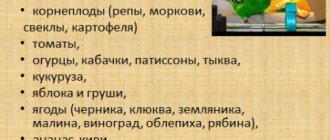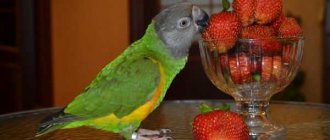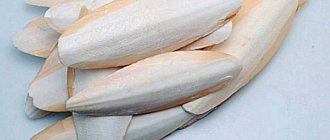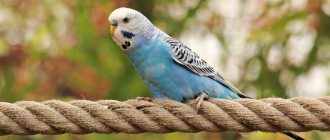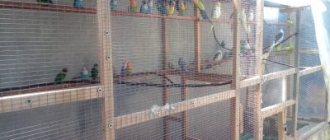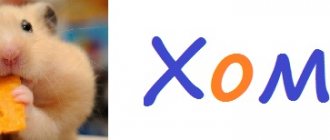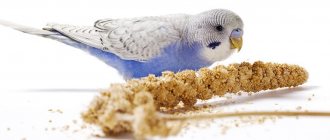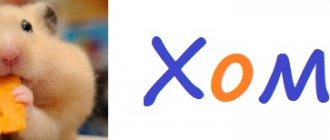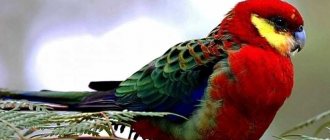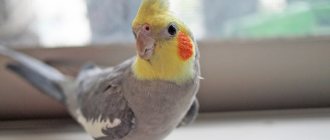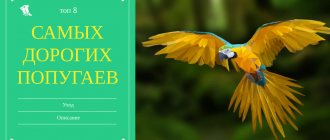Unusual delicacy
Chumiza for parrots is an annual cereal plant native to Asia and the CIS. In Russia, this product is grown mainly in the Far East. Externally, the plant looks like a two-meter bush with long leaves and straight stems .
Chumizu is also called black rice. Its grains resemble millet grains, but are smaller in size. This crop always produces a large harvest and is not afraid of drought.
The color of the plant depends on its variety; it can be light yellow or almost black or brown. The grains are used primarily to feed livestock and poultry.
If you have the opportunity to grow chumiza yourself, you should remember that it must be sown no earlier than spring. The earth should warm up to 10°C or more. Seeds must be buried within 5 cm.
This crop can enrich the soil with nitrogen, prevent the growth of weeds and improve soil structure.
In the photo there is a chumiza:
What is chumiza
Chumiza is an annual cereal crop known in ancient China. Now it is grown in countries such as Japan, India, Mongolia, Korea, as well as in Belarus, Ukraine, Kazakhstan, the Russian Far East and Georgia.
What is this culture like? This is a two-meter bush, consisting of seven erect stems, long, wide leaves and panicle-shaped inflorescences. Black rice grains are similar to millet grains, but are slightly smaller in size. This crop is not afraid of drought and produces rich harvests: in one spikelet of chumiza you can count about 6000 grains!
Cereals and flour are made from grain; delicious pancakes, pancakes, and flatbreads are baked from flour; grain is fed to livestock (both ducks and chickens, and cattle); Fresh greens and dried greens are also used as feed. This crop is used as green manure to enrich the soil with nitrogen, inhibit the growth of weeds and generally improve the soil structure.
Interesting! The oil is squeezed out of the stems of the chumiza. It is sometimes used in cosmetic products to strengthen hair and nails.
For parrots, chumiza is one of the best treats. Capitate millet can be fed not only to small budgerigars, but also to larger representatives of parrots.
Composition of the product
Due to its thin outer shell, chumiz is easily digested in the bird’s stomach, and all nutrients are instantly absorbed. Thanks to these properties, this plant can be fed not only to large and small parrots, but also to chicks.
Chumiza grains have the following composition :
- 5% fat;
- 7% proteins;
- 15% water;
- 7% fiber;
- 2% ash;
- 65% nitrogen-free extractives.
In terms of protein content, this plant is superior to other cereal crops. Chumiza grains contain vitamins C, E, A, K, group B. As well as calcium, sodium, phosphorus, fiber, sugars, iron and magnesium.
Available pectins and antioxidants have a positive effect on the body of birds.
Composition and beneficial properties
There is a wide variety of varieties of chumiza, which differ in the shape of the spikelets, the size of the stems and the color of the grains themselves: it ranges from yellow to brown-red.
Chumiza porridge tastes like semolina porridge, but it is much healthier.
In terms of protein content, black rice is much richer than corn, oat and millet grains. Unlike ordinary rice, which, by and large, consists of only starch, chumiz is richer and more varied in composition:
- vitamins of group B, as well as A, C, E, K, PP;
- pectins and antioxidants;
- fiber, ash and sugars;
- macro- and microelements are represented by calcium, selenium, magnesium, iron, silicon, manganese, sulfur, copper, potassium,
- phosphorus, zinc, sodium.
In terms of vitamin B1 content, chumiza surpassed wheat flour three times. In terms of vitamin B2 content, rice surpassed it twice as much. It contains more fats and nitrogenous substances than millet, buckwheat and barley seeds.
Birds that consume plague:
- have strong immunity;
- healthy heart and blood vessels;
- good metabolism;
- saturate the weakened body with useful substances;
- protected from toxic compounds and salts of heavy metals (including cesium and strontium);
- always active and cheerful.
Useful qualities for birds
Thanks to such a rich composition, black rice surpasses in its benefits almost all cereal crops available to birds. Chumiza has a positive effect on heart function, strengthens blood vessels, improves immunity and normalizes metabolism.
After the breeding season, molting or illness, parrots need a diet rich in vitamins. Chumiza will become an indispensable assistant in the matter of restoring the pet’s body .
The plant protects against the accumulation of heavy metal salts and toxic compounds. This culture gives parrots a boost of activity, improves their mood and receptivity to learning. The plumage becomes smooth and shiny, the beak and claws are maintained in a healthy condition.
In stressful situations, black rice grains have a positive effect on the bird’s nervous system, helping it to cope with this period more easily. When moving, you can also increase the usual dose of the product.
Pickup on other days.
The shelf life of the order is three days.
We will deliver the goods you need upon order to the selected Pickup Point the next day, after confirmation of the order by the operator. The possibility of delivering goods from the Online Store Warehouse to the Pickup Point must be clarified with the operator when confirming the order.
As soon as the goods ordered are delivered to the Pickup Point, we will send you an SMS indicating that the order is ready for pickup. If the order is not purchased within 3 days, the order will be cancelled.
Is there any harm
There is no harm to parrots from regular consumption of chumiz. They can eat grains in any quantity on a regular basis. However, it is not recommended to leave the plant freely available to your pet.
Birds really like the delicacy, so having an alternative in the form of chumiza, soon the bird will completely refuse its usual food . It is difficult to retrain a parrot; it will begin to demand exclusively black rice as food.
Chumiza should not be the basis of the diet; the bird's body needs a more expanded menu.
general information
Chumiza is familiar to many of those who keep poultry. This grain can be fed to small, medium and large parrots. It also has other names: black rice, capitate millet. However, not everyone knows the details about chumiz: what it is, how it grows and what its benefits are.
“Black rice” is an annual plant in the form of a bush, consisting of a dozen straight stems with wide leaves. The shoots grow up to 1.5 meters, and during flowering long panicles appear on the tops. The inflorescences are covered with small bristles and resemble spikelets. In place of the flowers, rounded fruits are formed - bags containing tiny grains.
This is interesting! The ear reaches a length of 12–30 cm, and contains 6000 seeds or more. The weight of one thousand seeds does not exceed 3 grams.
The peoples of Asia have long grown this valuable cereal crop. In the traditional cuisine of India, China and other countries, chumiza is used to bake bread, flatbreads, and cook porridge. They are used in livestock farming: green mass and hay are used to feed livestock, grain is used for birds. The plant is used as green manure. This is a green fertilizer that improves the structure of the soil, saturates it with nitrogen, and inhibits weeds. Before flowering begins, the soil is plowed, and then other crops are sown on it.
How to give it to a bird
The diet of birds should be as varied as possible and consist of different types of grain crops. Experienced breeders recommend giving chumiza grains no more than 3 times a week, in small quantities. As a rewarding treat, the plant will be an excellent addition to your usual diet.
A spikelet of chumiza should be hung from the bars of the cage or a couple of grain bags separated from the main stem should be placed in a bowl.
If the parrots are in the process of nesting, the daily rate of chumiza can be increased. During this period, birds need more vitamins and minerals.
Chumizu can be used for training or hand training. Birds will learn skills much faster and more willingly if you give them their favorite treat at the end. If your parrot has recently moved to a new home or changed its owner, tasty food will help it quickly adapt to new living conditions.
How to give chumiz to parrots
No matter how healthy and nutritious this product is, remember that it is a treat! You shouldn’t give your parrot spikelets all the time, otherwise he will soon refuse the rest of the food.
It will be enough to feed your pet 2-3 times a week: you can hang a spikelet over the cage or give 1-3 balls (depending on the size). A little more can be given during the molting and nesting period, when birds have an increased need for nutrients.
Use treats to encourage your parrot during training, taming your pet, or simply rewarding him for good behavior.
Look what a wonderful delicacy this is - chumiz for parrots:
Where can you buy and average price
Chumiza is sold mainly in pet stores. When looking for this plant, it is better to give preference to large chain stores; they have a wider range of products and are more likely to find what you need. It is extremely rare to find black rice in small salons. It is always in the poultry section.
Sometimes on packages they write “red millet” instead of “chumiz”. In fact, they are the same product, the only difference is in the name. When purchasing, be sure to check the spikelets for diaper rash and dryness. The grains should have a pleasant light aroma.
Black rice is sold in two types: premium and second grade. The former are distinguished by lush spikelets with large grains. The latter are more suitable for small birds or getting to know a treat.
The average cost of the highest grade ranges from 200 to 500 rubles per package, depending on the number and size of spikelets. The second-grade delicacy will cost less, from 100 rubles per pack. Price may vary due to quantity of contents.
Additional information on the topic of the article in the video:
Purchase
Today you can buy chumiza in online stores and in many pet stores. However, due to the fact that such a delicacy for parrots, rich in nutrients, is little known even to pet store sellers, some parrot breeders face difficulties in purchasing it.
However, it is worth looking for. Chumiza is very attractive to parrots. If you have a wild bird, with the help of this treat you will gradually be able to tame it. Not a single parrot can resist it, just like a cat cannot resist valerian.
On sale you can find two varieties of black rice:
- The highest grade has lush spikelets with fairly large grains. More suitable for large and medium-sized parrots, although, of course, smaller, wavy ones will also eat them with pleasure;
- Chumiza is the second grade - the spikelets are small, the grains are smaller. It is best to start introducing your pet to capitate millet with this variety.
Where to buy chumiz
Chumiza grows mainly in Southeast Asia, but now it is not difficult to buy it anywhere in the world. You can go to the nearest pet store to purchase or order capitate millet for your parrot. There are remote chain stores that deliver pet supplies through transport companies.
A good option is Nature's Red Millet Bird Treat from Vitakraft. The package contains several branches with grain, as well as a clothespin for securing the treat in the cage. The net weight is 80 g. Chumiza in ears has an important property: by tugging at the cob, the parrot gets food itself and satisfies its natural instinct. You should not give your bird tasty spikelets often, otherwise he will refuse regular food. Once a week is enough.
Attention! You should not offer your parrot a whole branch - he will not calm down until he has emptied it all. You need to pinch off about a quarter of the ear and then attach it to the twigs.
The longer the panicle, the higher the grade. 10 – 12 cm is a second-rate chumise. The lush spike, 20–25 cm long, belongs to the highest grade. It contains more seeds and they themselves are larger. For birds, they usually buy ears or loose grain of lower grades.
Not being sure what chumiza is, and buying it for the first time, can be confused with Senegalese millet. The ears of both crops are almost the same, but the grains of chumiza are distinguished by their uneven color - a mixture of white, yellowish, brown and red seeds. Senegalese millet has an even straw-yellow hue.
If you have difficulty purchasing “black rice” to feed your parrot, you can grow it yourself. This cannot be done on a windowsill or balcony. Given the size of the plant, you will need a plot of land to obtain a sufficient harvest.
Features of cultivation
Capitate millet can be grown on any soil, with the exception of solonets. This culture loves warmth and tolerates dry periods well. To prevent crops from freezing, you need to wait for a stable average daily temperature of at least +10ºC. Before planting, the soil is fertilized, dug up, leveled and warmed in the sun. The soil must not be allowed to dry out - the grain must fall into moist soil.
The seeds are prepared by soaking. After a day, they are dried, mixed with river sand to increase flowability and sown. 12–15 seeds are needed per linear meter. In order for large grain panicles to form, the distance between the rows of plants must be at least 50 cm. You can work manually or use a beet seeder.
Shoots appear a week after sowing. As soon as shoots appear, the beds or row-spacings are weeded. Then, as the stems grow, the soil is loosened from time to time. At first, the seeds need watering, but plants 10 cm tall are no longer afraid of drought. The roots go deep into the soil, where there is enough moisture.
The chumiza forms a dense bush, which creates shade, so the weeds gradually disappear. The harvest is harvested in dry weather, when the grain is fully ripe.
Chumiza is characterized as a product with high feed value. Farm animals whose diet contains this grain experience an increase in weight and productivity. The beneficial properties of the ingredient are especially evident in the example of ornamental birds: parrots receiving chumiza are distinguished by their physical activity and intelligence. The nesting period with such feeding is more successful: the chicks hatch stronger, and the female parrots recover faster.
